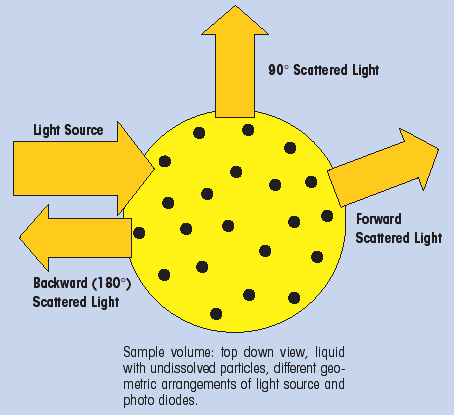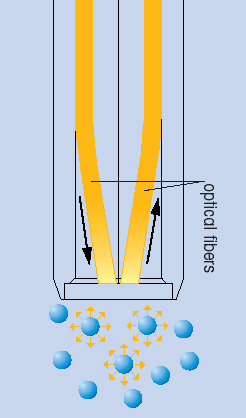Dieser Artikel ist noch nicht auf Deutsch vorhanden
Turbidity
Inhalt
 | Measuring techniques | |
 | Calibration |
- Solid (e.g. turbid apple juice or yeast cells in beer)
- Liquid (emulsified oil droplets in water, e.g. milk)
- Gas bubbles (e.g. undissolved CO2 in beverages)
Measuring techniques
All turbidimeters have in common that a beam of light is passed through the liquid. When this light beam hits on particles, the light is scattered in all directions (Fig. 1). The intensity of the scattered light is measured by photodiodes and the produced photo current is used as information on the concentration of the suspended particles. The higher the concentration, the higher the scattered light intensity. If light of the near infra-red region of the electromagnetical spectra is passed through the liquid (e.g. 880 nm), the influence of different colorings of the liquid created by dissolved substances is minimized. The intensity of the scattered light is not only influenced by the particle concentration itself. Particle size distribution, surface roughness and wavelength of the light passed through the liquid also contribute to the scattering efficiency of a sample. Furthermore the scattered light intensity depends on the angle in which it is measured. In practice different optical arrangements have been realized:- Backward 180º scattered light sensors
- Forward scattered light sensors
- 90º scattered light sensors

(Fig. 1: Scattering of light if a beam of light passes through a liquid with suspended solids)
The selection of the most appropriate sensor design depends on the application and the measuring task - e.g. for mid to high turbidities backward scattered light sensors show a better linear response with increasing concentration than other sensor designs.
A 12 mm probe design allows installation in retractable housings and consequently sensor calibration and possible cleaning without stopping the process. Furthermore the 12 mm probe design makes it possible to integrate optical fibers: the light is emitted from one fiber into the process liquid and the responding scattered light is transmitted via a second fiber (Fig.2).
Therefore light source as well as all electronical components can be installed in a single transmitter unit - if necessary at a safe distance to the passive sensor.

(Fig. 2: Typical fiber optic arrangement in a 12mm backscattering sensor)
Calibration
Due to the fact that the scattered light signal depends on a multitude of parameters, turbidity measurements are always a relative measurement. Sample calibration is mandatory if a direct correlation is to be evaluated between particle concentration (e.g. in g/l) and turbidity signal.The performance and measuring stability of a turbidimeter can be checked with turbidity standards. The most used standard is Formazin, an aqueous polymer suspension. It contains a highly consistent distribution of irregularly shaped particles and produces reproducible scatter of light. Most factory-calibrated turbidimeters are based on the use of Formazin standards. Measuring units based on Formazin are e.g. FTU (Formazin Turbidity Units), NTU (Nephelometric Turbidity Units) and EBC (European Brewery Convention).
 Nach oben
Nach oben


 Firmen
Firmen